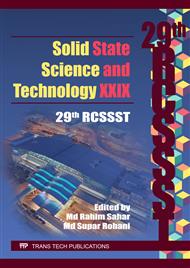[1]
L.H.C. Andrade, S.M. Lima, M.I. Baesso, A. Novatski, J.H. Rohling, Y. Guyot and G. Boulon, Tunable light emission and similarities with garnet structure og Ce-doped LSCAS glass for white light devices, J. Alloy Comp. 510 (2012) 54.
DOI: 10.1016/j.jallcom.2011.08.053
Google Scholar
[2]
A. Miguel, M. Al-Saleh, J. Azkargorta, R. Morea, J. Gonzalo, M.A. Arriandiaga, J. Fernandez and R. Balda, Spectroscopic properties of Er3+ doped furotellurite glasses, J. Opt. Mat. 35 (2013) 2039-(2044).
DOI: 10.1016/j.optmat.2012.09.022
Google Scholar
[3]
El-Mallawany, Tellurite Glass Handbook: Physical Properties and Data, Boca Raton CA, CRC Press, (2002).
Google Scholar
[4]
Fakhra Nawaz, M.R. Sahar, S.K. Goshal, Asmahani Awang and R.J. Amjad, Judd Ofelt analysis of spectroscopic properties of Sm3+ doped sodium tellurite glass co-doped with Yb3+. J. Luminescence, 147 (2014) 90-96.
DOI: 10.1016/j.jlumin.2013.10.049
Google Scholar
[5]
S. Akmar Roslan, M.R. Sahar, R. Arifin, S.K. Ghoshal, M.R. Supar and K. Hamzah, Optical Absorption of Er3+/Nd3+ Co-Doped Tellurite Glass, Adv. Mat. Research, 501 (2012) 96-100.
DOI: 10.4028/www.scientific.net/amr.501.96
Google Scholar
[6]
Anurag Pandey and Hendrik C. Swart, Luminescence investigation of visible light emitting Ho3+doped tellurite glass, J. Luminescence, 169 (2016) 93-98.
DOI: 10.1016/j.jlumin.2015.08.060
Google Scholar
[7]
W.M. Hua, W.P. Sum, E.T. Tew Z, Ibrahim and R. Hussin, Structural Study of Antimony Borate Glass System Doped with Transition Metal Ions Using Infrared and Raman Spectroscopy Adv. Mat. Research, 501 (2012), 71-75.
DOI: 10.4028/www.scientific.net/amr.501.51
Google Scholar
[8]
Azman Kasim, Ph. D Thesis, Universiti Teknologi Malaysia., (2010).
Google Scholar
[9]
Mott N.F. and Davis E.A., `Electronic Processes in Non-Cryst. Materials', Oxford: Claredon, (1971).
Google Scholar
[10]
Jacobs R.R. and Weber M.J., Dependences of the 4F3/2 – 4I11/2 induced-emission cross section for Nd3+ on glass composition, IEEE J. Quant. Elect., 12 (1976) 102.
Google Scholar
[11]
Feng Zhang, Zhuanfang Bi, Anping Huang and Zhisong Xiao, Luminescence and Judd Ofelt analysis of the Pr3+ doped flurotellurite glass, J. Luminescence, 160 (2015) 85-89.
DOI: 10.1016/j.jlumin.2014.11.047
Google Scholar
[12]
Jayasimhadri, M., Rama Moorthy,L. and Ravikumar, R.V.S.S.N., White emission materials from glass doped with rare earth ions: A review, J. Opt. Mat., 9 (11) (2007) 1321-1326.
DOI: 10.1016/j.optmat.2006.06.007
Google Scholar
[13]
Kindrat I.I., Padlyak, B.V. and Lisiecki, R., Judd Ofelt analysis and radiative properties of the Sm3+ centres in Li2B4O7, CaB4O7 and LiCaBO3 glasses, J. Opt. Mat., 49 (2015) 241-248.
DOI: 10.1016/j.optmat.2015.09.024
Google Scholar
[14]
Moorthy L.R., Jayasimhadri M., Saleem, S.A. and Murthy, D.V. R, Optical properties of Er3+-doped alkali flurophosphate glasses, J. Non-Cryst. Solids, 353 (2007) 1392-1396.
DOI: 10.1016/j.jnoncrysol.2006.10.062
Google Scholar
[15]
Carnall, W.,T., Fields, P.R. and Rajnak K., Electronic energy levels in trivalent lanthanide aquo ions Pr3+, Nd3+, Pm3+, Sm3+, Dy3+, Ho3+, Er3+ and Ho3+, J. Chem. Phys., 49(40) (1968) 4424-4443.
DOI: 10.1063/1.1669894
Google Scholar
[16]
Yu,Y., Chen.D., Ma, E., Wang, Y. and Hu, Z., Spectroscopic properties of Nd3+ doped transparent oxyfluoride glass ceramics Spectrochimica Acta Part A: Molecule and Biomolecular Spectroscopy, 67(3-4) (2007) 709-713.
DOI: 10.1016/j.saa.2006.08.028
Google Scholar
[17]
Ahmadi, F., Hussin.R. and Ghoshal, S.K., Judd Ofelt intensity parameters of samarium-doped magnesium zinc sulfophosphate glass, J. Non-Cryst. Solids, 448 (2016) 43-51.
DOI: 10.1016/j.jnoncrysol.2016.06.040
Google Scholar
[18]
Jorgensen, C.K. and Reinsfeld, RJ. Future technology application of rare earth doped materials, J. Less Common Met., 93 (1983) 107.
Google Scholar
[19]
Tanku, Y.A., Ghoshal, S.K. and Sahar, M.R., Ligand field and Judd Ofelt intensity parameters of samarium doped tellurite glass, J. Moleculer Structure, 1117 (2016) 64-68.
DOI: 10.1016/j.molstruc.2016.03.083
Google Scholar
[20]
Kumar, K.U., Prahyusha, V.A., Babu,P., Jayasankar C.K., Joshi A.S., Speghini,A. and Bettinelli, M, Fluorescence properties of Nd3+-doped tellurite glasses, J. Spectrochimica Acta Part A: Biomolecular Spectroscopy, 67(3-4) (2007), 702-708.
DOI: 10.1016/j.saa.2006.08.027
Google Scholar
[21]
E.O. Serqueira, N.O. Dantas, A.F.G. Monte and M.J.V. Bell, Judd Ofelt calculation of quantum efficiencies and branching ratios of Nd3+ doped glasses, J. Non-Cryst. Solids, 352 (2006) 3628-3632.
DOI: 10.1016/j.jnoncrysol.2006.03.093
Google Scholar


